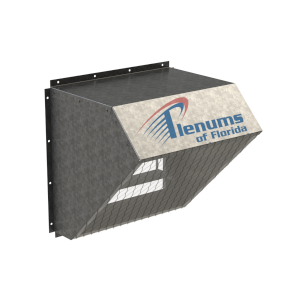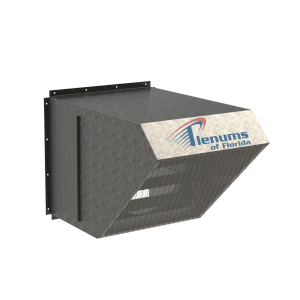Product Search
New Unit
Outdoor Air Hoods for HVAC RTU
An outdoor air hood is a device that allows for air to enter or exit a building while preventing the ingress of debris, rain, snow or small animals into the HVAC ducting system. There are code requirements for ventilation such as ASHRAE Standard 62.1-2019, which clearly define the amount of outside air required. Plenums offers three types of outside air hoods as listed in the table below with their function described below. When applied to a specific RTU unit, the Outside Air Hoods are rated by the percentage of Outside air that the hood can deliver in increments of 25%, 50% or 100%.
Depending on the use case, these hoods are often used instead of mixing boxes but can be used in conjunction with our Economizer Mixing Boxes as well. For a discussion of applicable codes and standards, please visit Energy.gov.
- Galvanized steel construction
- Back draft damper
- Expanded metal bird screen
- Shipped fully assembled
OUTSIDE AIR HOODS
- Galvanized steel construction
- Manual adjustable or automatic damper blades
- Expanded metal bird screen
- Optional aluminum filter
- Custom options available
- Galvanized steel construction
- Back draft damper
- Fan assembly with motor
- Expanded metal bird screen
- Shipped fully assembled
Barometric relief hoods are used to prevent over pressurization of the building envelope. They act as a check valve to allow air out of the building when the pressure is too high but prevents air from flowing back into the building.
Outside air hoods are typically used to allow air into the building (makeup air) when some return air is being vented to the outdoors for ventilation purposes. A manual outdoor air hood has the disadvantage of staying in its set position whether the HVAC unit is running or not. This allows for venting or ingress of air when it is not efficient to do so. An automatic outside air hood improves efficiency over the manual air hood by opening the dampers with a two-position actuator when the HVAC unit is running. This allows venting only when the HVAC unit is on and closes the damper when the HVAC unit is not operating.
Power exhaust hoods use back draft dampers similar to the barometric relief hoods but also incorporate a motor driven fan blade that causes the dampers to open when the fan is running to force air out of the building for a more controlled ventilation condition. The backdraft damper prevents backflow of air back into the building.
Mixing boxes can be used in conjunction with any of these types of hoods to meet your building ventilation or energy efficiency requirements. Contact us for help on selecting the products for your application.
NEW: COLOR OPTIONS




